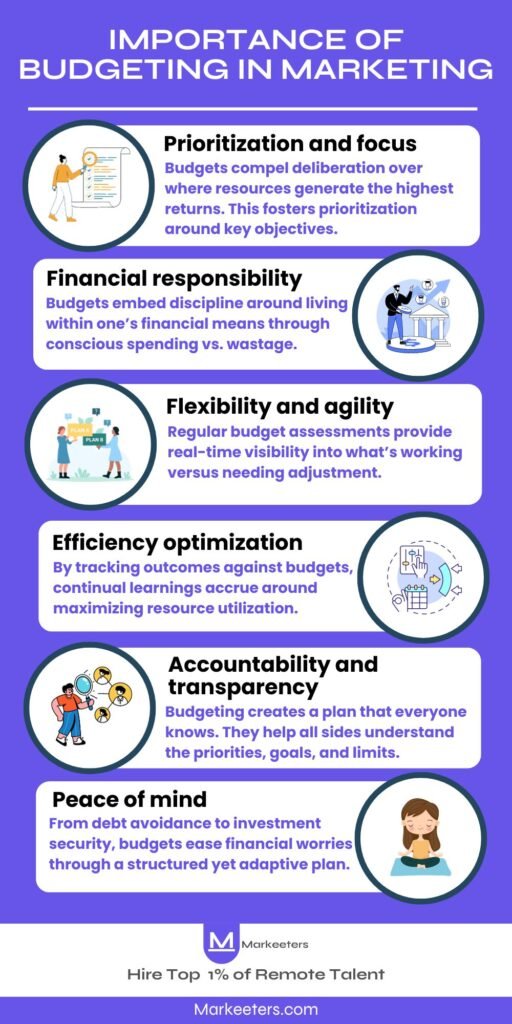Every business, whether big or small, needs a deliberate marketing approach to guide visibility efforts and resource allocation. A well-architected plan serves as a shared roadmap, delineating your unique value proposition while establishing aligned expectations internally. For startups, especially where founders juggle many roles, structuring the foundational framework demands care. 22% of startups that fail don’t have a sound marketing strategy. Statista carried out a survey among start-up owners, and the main reason why their businesses did not work out was running out of funds, with 38 per cent.
Stakes rise further, considering the compressed experience curve facing emerging ventures. Rather than viewing potential pitfalls as failings, however, we can extract lessons. Common marketing budgeting mistakes often stem from underestimating marketing’s complexity or neglecting nuanced considerations that shape optimal strategies. By unpacking recurrent oversights startups make that sidetrack execution, this report aims to equip yours with forearming perspectives.
Budgeting is crucial but tricky for startups with limited funds. This post covers the top errors fledgling companies make when allocating marketing dollars so you can steer clear of waste.
What is Budgeting?
Allocating financial resources thoughtfully lays the groundwork for any promotional efforts. For startups especially, navigating this initial budgeting exercise demands nuance.
Rather than view funding constraints narrowly, the wise and experienced strategist recognizes opportunity. Limited means birth creativity – each dollar deployed serving as kindling fueling ingenious visibility solutions.
Specifically, allocating budgets acutely targets paid, owned, and earned categories. “Paid” incorporates search, social, and display to test messaging resonance. Meanwhile, “owned” channels like your web and blog presence optimize qualified traffic.
And “earned” pursues quality backlinks and shares sustainably endorsing your authority. Judiciously weighing resource distribution across these three spheres establishes an aligned marketing framework.
Regular review ensures flexibility in responding to shifting customer understandings. Metrics track efficacy, revealing where sparking awareness proves most impactful. Ongoing learning cycle investments closer to desired objectives.
Why is Budgeting so Crucial?
Budgeting serves as a vital tool for planning and goal-setting across all levels, both personal and professional. Here are some thoughts on why budgeting is so universally important:
- Prioritization and focus: Whether allocating weekly grocery funds or departmental enterprise expenses, budgets compel deliberation over where resources generate the highest returns. This fosters prioritization around key objectives.
- Financial responsibility: From household savings goals to corporate profit targets, budgets embed discipline around living within one’s financial means through conscious spending vs. wastage.
- Flexibility and agility: Regular budget assessments provide real-time visibility into what’s working versus needing adjustment. This facilitates nimbly shifting allocations to capitalize on evolving opportunities.
- Efficiency optimization: By tracking outcomes against budgets, continual learnings accrue around maximizing resource utilization. Over time, costs progressively align closer to desired value yields.
- Accountability and transparency: Budgeting creates a plan that everyone knows. Whether deciding on meals for the family or large business investments, budgets give clarity upfront. They help all sides understand the priorities, goals, and limits.
- Peace of mind: From debt avoidance to investment security, budgets ease financial worries through a structured yet adaptive plan accommodating life’s ebbs and flows.

Also Read: How to Setup Marketing Budget for Your Startup
Budgeting is a Travel Plan for Your Startup Journey
Let’s understand the need to budget by taking it as a travel plan. Travelling without a plan means headaches and wasted money. It’s like flying overseas without booking somewhere to stay – doing marketing without a plan leads to wasted effort.
No goals means campaigns don’t have focus, like heavy rain instead of targeted watering that helps things grow. Scrambling at the last minute means spending money with no purpose.
Not thinking ahead leaves you with a chance for activities. Going with the flow sounds fun but isn’t organized. Marketing works the same – random ads may get attention but don’t tell a full story.
Budgeting helps manage expectations and spending. Like saving for lodging before travel, guardrails prevent wasteful spending. Setting costs straight helps explore destinations effectively.
Learning from data and testing is best. Experiments show what really attracts customers versus hoping for viral luck. Budget planning powers understanding versus chance outcomes. Small changes march to clear destinations.
In summary, blind travel or marketing breeds frustration, not satisfaction. Careful schedules make experiences. Strategic spending optimizes returns again and again. Planning beats unpredictability for stronger branding.
Key similarities between creating a marketing budget and planning a travel itinerary
- Clear destination: As travel plans set out arrival dates and destinations in mind, budgets clarify marketing goals – whether visitor numbers, leads generated, or products sold. Goals keep spending purposeful.
- Budget allocation: Just as travel budgets allot dollars towards flights, accommodation, and activities accordingly, marketing allocates funds upfront across channels based on intended outcomes.
- Timing consideration: Travel factors in times for flights, and journeys to optimize a schedule; budgets consider campaign durations and seasonal peaks. Proper sequencing yields cumulative impact.
- Flexibility factor: Unexpected delays or expenses may alter travel plans on the go; marketing budgets also factor agility to reallocate if efforts under/overperform for adjustments.
- Attention to detail: Organized travel files outline logistics, and timetables; marketing parallels with detailed asset schedules, supplier agreements, and timelines. Execution stays seamless.
- Room for exploration: While maintaining core planned stops, travel budgets breathe flexibility for unplanned discoveries; marketing analogously experiments with testing assumptions to expand reach.
- ROI tracking: Trip reviews assess costs against experiences; marketing KPI tracking makes post-campaign assessments to refine future cost-efficiencies.
Forethought grants efficiency and impact whether venturing into new markets or places.
Now we shall head to the main part of this blog. Let’s discuss the common marketing budgeting mistakes.
Common Marketing Budgeting Mistakes
With limited funds, every step as a startup needs more care and thought behind it. As it is said, “Learn from the mistakes of others. You can’t live long enough to make them all yourself.” we can keep in mind these common mistakes and prepare ourselves to avoid making them while planning.
Mistake #1 – Not tracking ROI
Proper tracking and reporting are the foundation of sound budget management. However, in the frenzy of daily operations, it’s easy to lose sight of the most critical metric – return on investment. Without ROI data, marketers cannot distinguish between high and low-performing campaigns. Over time, wasteful activities will consume disproportionate funds that could have been better deployed elsewhere.
Let’s explore this issue in more depth:
As startups focus on quick growth, there is immense pressure to engage customers at every touchpoint. This leads many founders to simply invest in all ideas without establishing clear KPIs (key performance indicators). While experimentation is good, budget opacity helps no one.
It’s essential to define what “success” means for different channels – e.g. lead count, signups, and bills raised. Install Google Analytics to track Goal Completions, E-commerce, etc. Categorize campaigns as a direct response (measurable ROI immediately) vs. brand-building (longer-term impact).
Evaluate ROI via cost per lead/conversion metrics weekly. Shift future allocations towards channels consistently surpassing goals relative to investment. Monitor ROI beyond top-line figures too – quality scores, customer lifetime value, etc. for optimized outcomes.
It’s not enough to simply monitor aggregate metrics – startups must drill down to evaluate ROI at the campaign and medium levels. For instance, while social ads may prove worthwhile overall, specific campaigns or ad sets within could drag down performance.
It’s always advised to set “ROAS thresholds” – return on ad spend minimums required for continued investment. Redeploy underscoring initiatives rapidly instead of clinging to sunk costs.
Finely tuned campaigns demand persistent testing and refining. Weekly spent and conversion reviews help optimize creatives, targeting, and bids. I also suggest A/B tests where feasible to uncover the highest-performing formats/headlines.
Don’t neglect non-digital efforts also impacting offline goals. Consider omni-channel analytics integrating online and offline data to track ROI holistically.
Must Read: How to Prioritize Marketing Channels Based on ROI
Mistake #2 – Scattershot spending
We can see this mistake all too often in startups eager to “get their name out there.” Without clear direction, marketers end up dabbling in every possible channel. But spreading limited funds too thin dilutes impact.
It’s crucial to first identify your ideal customer persona(s) based on product-market fit research. Where do these avatars currently spend time online? Social platforms like Facebook and LinkedIn may prove most effective for B2B, while Instagram works well for younger consumer-facing brands.
Once top priorities are settled, study analytics from sites/apps these personas frequently to zero in on the highest potential mediums. Allocate a set budget each month e.g. 60% to Google Ads, 30% Instagram ads, and 10% influencer outreach on TikTok.
Resist FOMOing into every new platform unless data is justified. Continually refine strategy testing different channels/personas but avoid day-to-day lurches based on shiny new tools. Without focus, hard-earned dollars get frittered away accomplishing little.
Beyond personas, startups must also map the ideal customer journey – common pathways that lead to purchase. Spending varies according to the journey stage – more awareness plays early on, and elevated engagement ads as interests grow.
Segmenting the database into exploration, consideration, and advocacy stages helps target allocution precisely. Measure each group’s pathway to optimize touchpoints delivering the highest conversion lift.
Testing assumptions regularly remains vital. Customers evolve, as do their habits. Annual reviews of top channels/personas against shifting KPIs prevent wasting money on legacy strategies that no longer fit.
ROI alone does not determine the channel mix. The synergy between different mediums amplifies the impact. Integrate launchpads to broaden the scope. For example, social media posts that encourage newsletter signups can fuel retargeting campaigns.

Mistake #3 – Relying too heavily on paid ads
Paid channels like search, social media, and display ads hold great potential for startups seeking immediate reach. But this effectiveness comes at a cost. Remarketing lists take time to populate. Ad budgets drain quickly if over-leveraged from the start.
It’s important to complement paid promotion with efficient organic tactics requiring minimal monetary investment beyond time. Content assets like blogs educate target keywords in search while building authority. Social media engagement breeds following and shares. Email subscribers exposed to crafted stories become advocates further amplifying messaging.
Search engine optimization implemented alongside paid search helps lock in qualified traffic even after ads pause. Well-optimized websites rank highly organically for longtail intent phrases buyers commonly query.
Having a solid foundation of evergreen content and an engaged community to fall back on ensures startup marketing gains resilience beyond the boom and bust of budget cycles. Advertising works best when supercharging pre-existing considerations rather than shouldering the entire awareness workload alone.
Here are some specific organic tactics startups can use:
Blogging is crucial. Focus on quality over quantity, deeply solving core customer pains via tailored topics. Include relevant keywords naturally. Integrate interactive elements like questions to encourage comments.
Social media requires post variety – uses, tips, and stories keep followers engaged between promotional updates. User-generated content like photos and reviews showcases real customer value.
Email remains key. Provide value-packed, skimmable updates weekly/bi-weekly in a personal tone. Foster relationships by addressing readers individually. Insert CTAs like limited webinar spots to nudge subscribers towards further commitment.
Website usability must motivate revisits through helpful resources section, FAQs, and speedy experience across devices. Internal linking binds pages under one navigation flow.
For more insights on PPC, Read: What Is PPC? Basics of Pay-Per-Click Marketing
Mistake #4 – Overlooking basic SEO/website fundamentals
Given endless new platforms, startups easily prioritize flashy channels over crawlable foundations. However, search and the website represent the primary gateways driving consideration for most buyers.
Before streaming budgets elsewhere, ensure on-page optimization by:
- Researching the top 3-5 keywords/phrases aligning with user intent for each key page
- Crafting unique, structured titles and meta descriptions for bots and users
- Creating internal linking between category pages for seamless navigation
- Adding relevant images/videos caring for quality, file size, and alt-text
Leverage keyword gap analysis to expand important topic coverage over time. Monitor technical health with regular audits of speed, security, and mobile-friendliness.
Equally crucial – understand target personas’ common information needs and pain points. Then structure UX accordingly via easy scanning and helpful callouts for quick resolution. Trust and safety tags to alleviate concerns complete the experience.
Having a strong online foundation establishes credibility for leads to be converted into customers down the pipeline via multiple touchpoints.
SEO is such an important topic that it deserves more breadth of discussion. Let me expand on a few additional elements startups should consider:
- Content: While keyword-optimized pages are crucial, don’t forget longer-form articles, guides, and case studies. Diverse formats boost crawlability and educating readers supports query intent better than sales copy alone.
- Links: Begin link building gently through guest posts, and local citations. Respect quality over quantity. Develop topical resource pages purely serving readers as a link magnet over time.
- Speed: Homepage speed impacts organic placement. Monitor a11y, server response with Google PageSpeed Insights. Consider a CDN, image optimization, and caching. Today’s competitive landscape demands rapid load times.
- User Experience: Ensure coherent internal navigation and search. Provide calls-to-action for lead capture without detracting from information architecture. Test homepage conversions via landing page tests.
- Analytics: Correlate organic traffic and goals to keyword strategy effectiveness. Refine underperforming topics but sustain winners for long-tail queries. Continual testing and refinement strengthen SEO over time.
Must Read: 15 Powerful Reasons Your Business Requires SEO Today
Mistake #5 – Failing to re-evaluate budgets
As startups’ understanding of their markets and customers deepens over time, so too should their approach to spending evolve. What delivered outcomes at $5k monthly may not prove effective multiplied tenfold.
Rigorous monthly assessment maintains the optimization discipline needed to extract maximum value from expanding war chests. Key review areas include:
- Channel performance relative to changing goals
- Adjusting budgets according to new placement within growth funnels
- Revisiting customer personas and purchase triggers
- Retesting ads, and landing pages based on the latest insights
- Benchmarking industry norms and best practices
Larger budgets afford testing advanced tools – programmatic, location-based ads. But constantly challenge legacy spending justification too.
Scaling necessitates redeploying Martech efficiencies – automation, and cross-channel reporting. Consider third-party platforms streamlining workflow.
Agility ensures chase coffers fuel continued momentum. Review not just numbers but strategic fit constantly. Sustained growth demands nimble responsiveness to shifting sands.
Here are a few additional insights we believe could help round out our advice:
- Test different budget ranges monthly to assess the impact on key metrics. Gradually increase top performers but be willing to pause underperformers.
- As the sales cycle lengthens, shift focus from quick conversions to nurturing consideration over weeks/months. Longer journeys require patience.
- Market changes like new competitors, and product pivots also warrant strategy recalibration to stay relevant.
- As you learn more qualities of high lifetime value customers, refine buyer personas and targeting accordingly vs. initial assumptions.
- Budget more for brand awareness once product-market fit proves scale. Early recognition lays the foundations for enduring demand.
- Don’t neglect organizational learning. Conduct post-campaign reviews; survey customers on touchpoint pain points/preferences for continuous refinement.
- Outsource specialist tasks like analysis, and audits that expand bandwidth without busting budgets.
Must Read: How to Setup Marketing Budget for Your Startup
Case Studies
Relating the common mistakes to actual examples startups may face would help drive the points home more effectively. Let us try fleshing out a couple of scenarios:
CASE 1
Imagine a fledgling SaaS startup called Startup A that helps teams coordinate calendars. In their first year:
- Mistake 1 (ROI): Excited by new user growth, they allocated 40% of funds to Google Ads without setting targets. High click costs didn’t convert enough trials to offset.
- Mistake 2 (Scattershot spend): Trying everything, they spread dollars thinly across social, influencers, and podcast ads. But no channel drove meaningful signups on its own.
- Mistake 3 (Over-reliance on paid): By year 2, 80% went to pay due to promises of instant traction. However, budgets dried up before real customers emerged.
- Mistake 4 (SEO fundamentals): Their site lacked optimized pages for common searches like “team calendar app”. Rivals ranked higher, diverting organic traffic.
- Mistake 5 (Budget inflexibility): As the product evolved, budgets didn’t shift from early tactics now less relevant. They missed scaling opportunities.
By identifying stretched budgets as the root cause early on, they could have tested smaller amounts more strategically across channels until they found the right recipe.
After the initial struggles, their new growth hacker advocated a “test-and-learn” mindset. She saw potential in refining strategy based on hard data.
First, she dialed paid back 50% for 6 months, focusing ads on their most engaged trial segment – teams of 5-20 users. Spending the same amount yielded 5x more conversions through precise targeting.
She launched an informative blog leveraging team productivity insights. Through SEO, it became the #1 result for “Group Calendar Questions,” driving steady organic traffic.
Their new referral program offered discounts for member-get-member signups. Advocates spread the word, bringing in higher-quality leads at lower CAC.
By the 3rd year, refined personas and purchase journeys powered cross-channel campaigns. Awareness grew through rationalized paid and shareable social content. Engagement funnels smoothly progressed warm leads toward dedicated reps.
Renewal rates climbed as the serendipitous exploration-stage trials converted baptized customers better understanding of Startup A’s value. Data-driven testing continuously sharpened strategy, fueling sustainable expansion.
CASE 2
Here is a fleshed-out case study of a startup called Startup B that encountered similar issues:
Startup B is a calendar syncing and scheduling app founded a few years ago. With $250k in seed funding, they focused on product development and initial marketing.
Within 6 months, they had 5k free users but struggled to convert trials. Spending heavily on paid ads, only 2% signed up for premium accounts. Knowing more testing was needed, co-founder Lucy took charge of marketing optimization.
Lucy discovered that 80% of their $10k monthly budget went to Google Ads with no goals set. She decreased spend by half and set conversion targets. Testing ad formats against user behaviors, she increased ROI by 300% within 2 months.
With these learnings, Lucy launched A/B segmentation tests. She found teams under 10 saw 15% higher trial conversion when onboarded step-by-step versus an overload of features.
Meanwhile, SEO brought in few organic visits as competitor ranking dominated keywords. Lucy trained the team on technical SEO best practices like optimizing pages and addressing 404 errors.
Pulling all data streams into a customer journey map, Lucy identified major drop-off points. She developed targeted campaigns to strengthen engagement at each stage like exclusive deal alerts for prospect nurturing.
Within a year, Lucy helped increase paid conversion by 300%, organic traffic by 50%, and monthly retention by 15%. Customer acquisition costs dropped while lifetime value climbed.
Through her methodical, data-driven approach, Lucy optimized StartupB’s budget allocation and streamlined strategy execution. Testing fundamentals like targeting, offers, and SEO strengthened Marketing ROI, fueling continued scaling.
Conclusion
While the allure of shiny new tools tempts startups daily, marketing truly succeeds by staying laser-focused on what drives business. Limited early budgets necessitate extracting maximum ROI from each campaign. Constantly optimize allocation by measuring what resonates with core buyers at each stage.
Avoiding mistakes like overlooking ROI, diluting impact through scattershot spending, and ignoring fundamentals grants perspective to guide strategic choices. Balancing awareness with channels of nurturing consideration yields well-rounded results.
More importantly, maintain agility. Review assumptions relentlessly against shifting realities. Evolve budget mix timely in response to maturing products, expanding customer base, and deeper customer understanding.
Only through such discipline – tracking key metrics religiously, testing assumptions frequently, and adapting strategy dynamically – can startups craft marketing resource allocation fueling enduring growth. Every dollar deployed must echo the brand mission and edge businesses closer to ambitious goals. Done right, even tight budgets unlock boundless potential.





